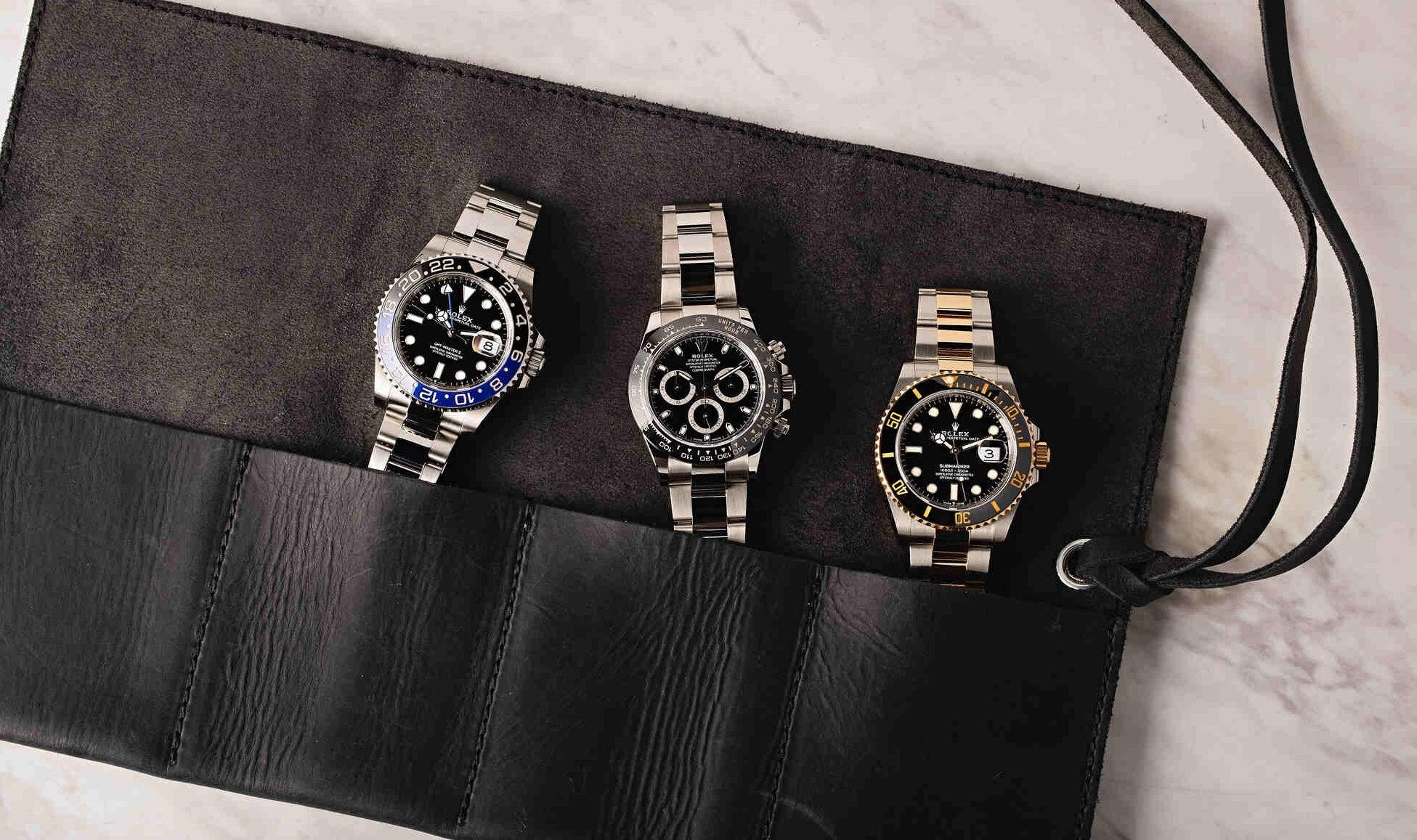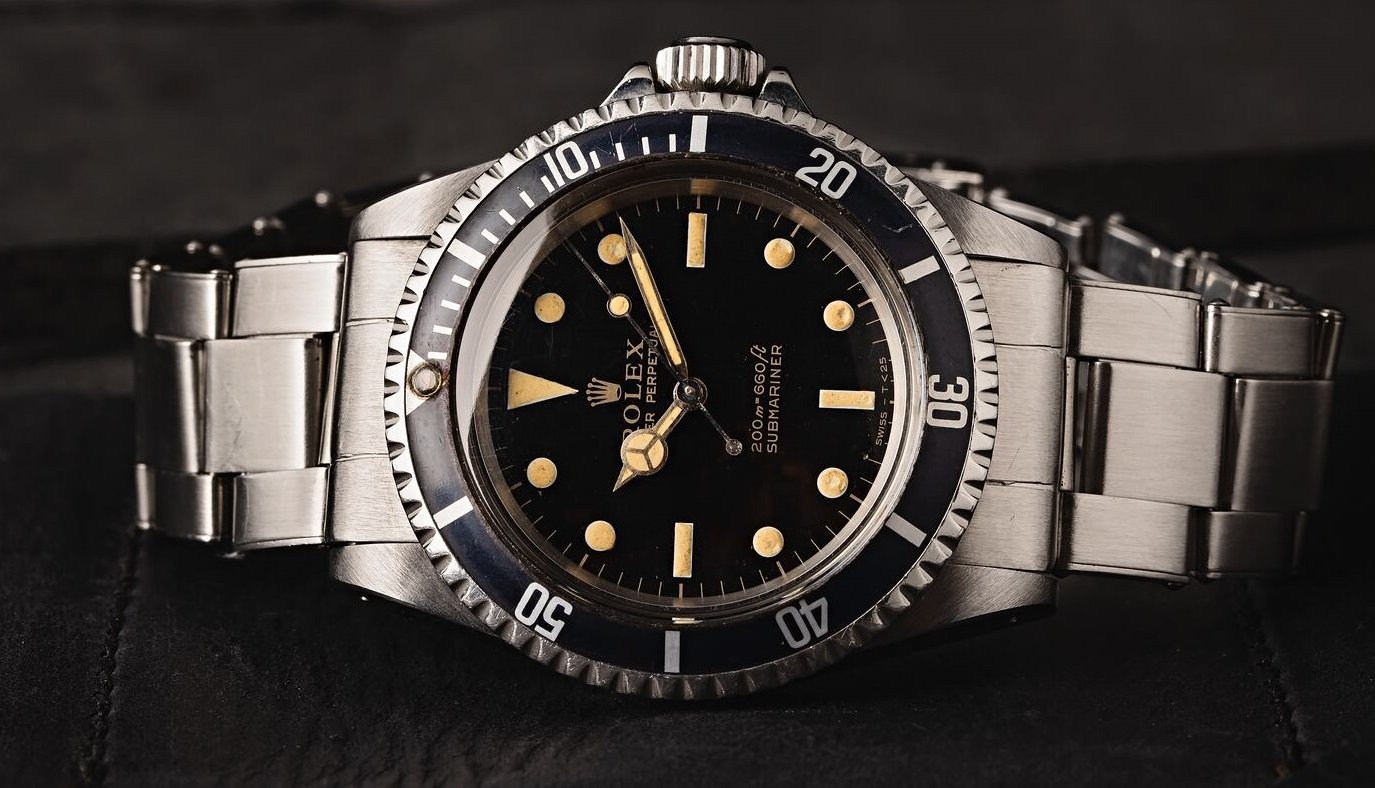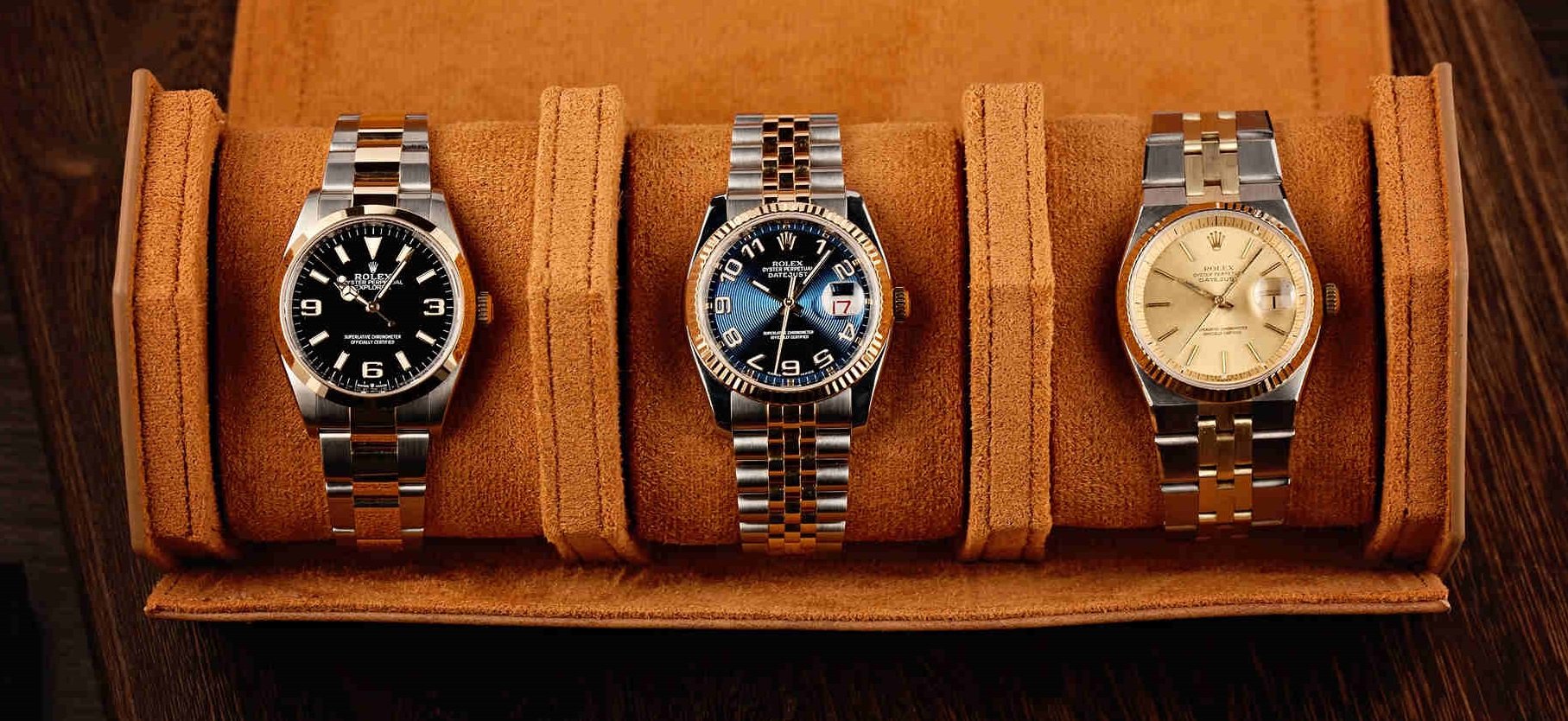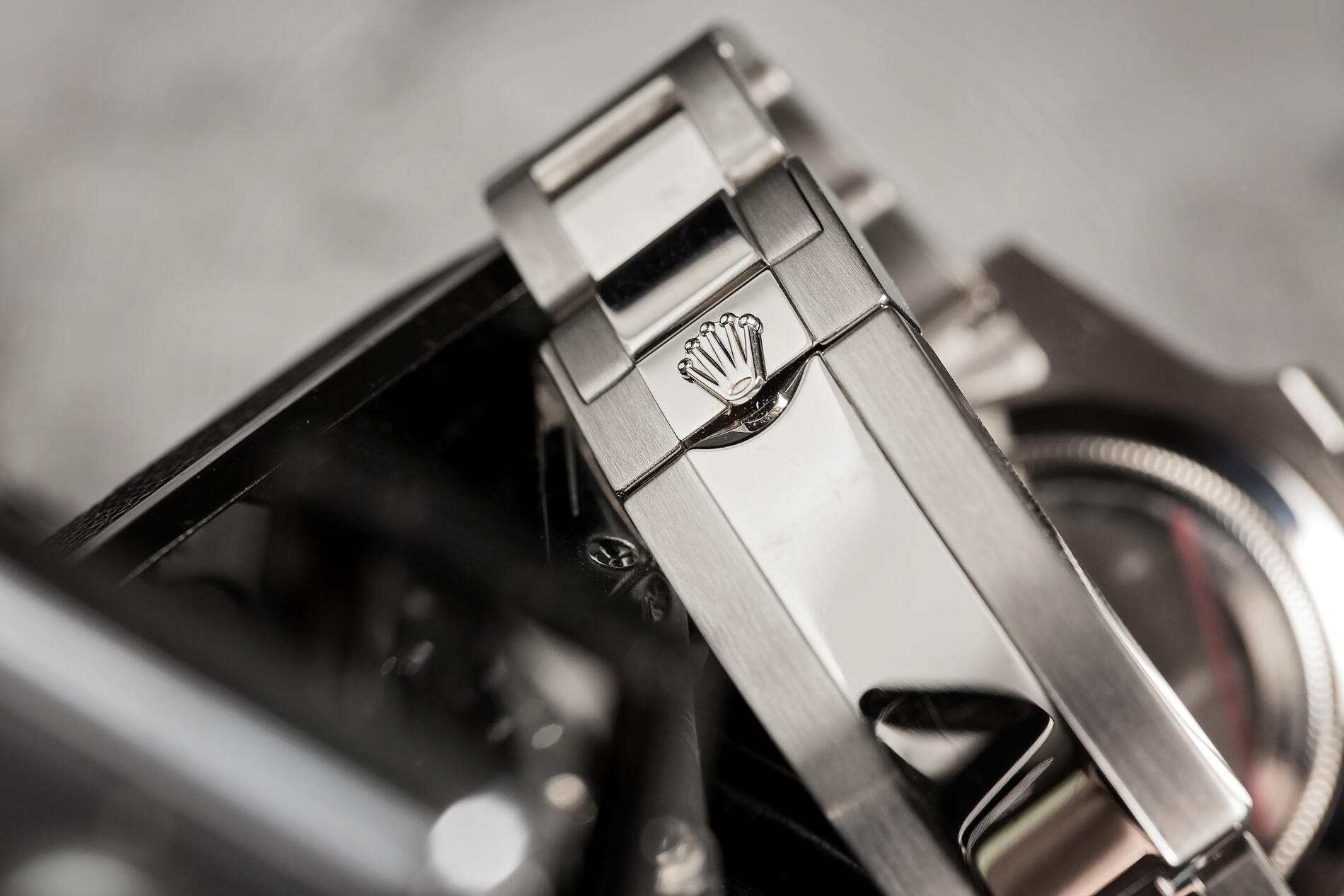Rolex Terminology, Definitions and Reference Glossary
The world of luxury watches can be confusing. Especially new collectors who are navigating a Rolex definition that they are unfamiliar with. There are hundreds of watch specific terms that can confuse even the most seasoned of veterans.
If you every come across a word or phrase that you are unfamiliar with, this page can be a resource for you. Learn the meaning or definition of each word or phrase in our Rolex vocabulary index below. Use this page as your reference guide for all things (definition, Rolex terminology, or otherwise) related to Rolex watches. Other useful guides include our Rolex Production Dates by Serial Number, Rolex Price Guide. To learn more about Rolex watch terminology, the Company, its history and founding, please visit our dedicated Rolex page.
Commonly Used Rolex Terms

- Two-tone: also commonly referred to as steel & gold, 2-tone and Tu Tone, this Rolex term is used to describe a watch made of two different metals - most typically stainless steel and yellow gold.
- Submariner or Sub: The Submariner is one of the most popular watch models made by Rolex. It was first launched in 1954 as a divers watch for its ability to withstand moisture and water. It is featured in their professional line and is the "iconic" Rolex sport watch.
- Cosmograph Daytona: A term used for Daytona's with a self-winding, mechanical chronograph manufactured since 1963.
- Bezel: The metal ring outside of the crystal. Throughout the years, Rolex has used a few different materials to make their bezels. The most common materials used in Rolex bezels are steel and their patented Cerachrom material. Other common materials used by Rolex for their bezels include Bakelite and aluminum.
- Bezel insert: On some professional models the bezel uses a removable insert to indicate different functions I.E. time elapses, 24 hour etc.
- Stainless Steel: The non precious metal material used to make the case and bracelet of Rolex watches. The stainless steel Rolex uses is called 904L and is especially resistant to corrosion. 904L differs from 316L stainless steel because of extra Chromium, Molybdenum, Nickel, and Copper alloys which gives it improved resistance to acids.
- Diamond Dial: this term is used to reference any dial that has diamond hour markers instead of dot indices or other type of standard markers.
- Diamond Bezel: Generic term referring to any bezel that has diamonds. This is more commonly seen on the Datejust and Presidential models of Rolex watches.
- Oyster bracelet: large center link bracelet - found on most Rolex watches from their sports model category.
- Jubilee: the more elegant bracelet is featured on some of the dressier Rolex watches, including the Day-Date and Datejust models, but can also be seen on vintage the GMT-Master models as well as their newly released stainless steel GMT-Master II "Pepsi." The Jubilee is defined by the 3 small center pieces in the middle of the bracelet.
- President: also commonly referred to as the Rolex Presidential, this high end watch bracelet features a shorter middle section than the oyster bracelet and is only featured on their Day-Date series of watches. Previously, this bracelet was only available in solid gold, but in recent years Rolex has begun to produce their famed President bracelet in white gold, platinum, and patented Everose gold.
- Datejust: The quintessential Rolex watch. This is the model most people think of when they hear the word Rolex. The name is derived from its function: the face of the Datejust displays the day of the month in a small window on the right side of the dial.
- Vintage Rolex: Generic term for any Rolex that is 30+ years or older.
- Cerachrom: Refers to the ceramic composite material used in the modern bezels on GMT, Submariner and Daytona models.
- Pepsi Dial: this is a commonly used term for the blue and red bezel inserts featured on GMT-Master and GMT-Master II models.
- Coke Dial: this is a commonly used term for the red and black bezel insert on the GMT-Master and GMT-Master II models.
- Green: This is the color Rolex uses to “celebrate” an event. Examples include Green bezel for the 50th anniversary submariner, green crystal on the Rolex Milgauss, and the green dial on their gold GMT-Master II.
- Black: Color used to describe a dial or some bezel inserts.
- Yellow: Color often used as a slang term to describe a watch that is entirely 18k yellow gold. I.E. a "yellow" watch.
- White: Color used to describe dial color or a slang term to describe a watch that is entirely 18k white gold, I.E. a "white" watch.
- Pink or Rose: Color - used to describe dial color or a slang term to describe a watch that is entirely 18k pink gold, I.E. a "pink/rose" watch.
- Blue: Color used to describe a dial or some bezel inserts.
- Date: Feature common to most Rolex models, it indicates the day of the month in numerical fashion at the 3 o'clock position.
- No Date (non-date): Indicates the absence of the date feature on specific models - this is not an official Rolex term. If a model does not have a date feature, Rolex refers to it just as an Oyster Perpetual, I.E. the Oyster Perpetual Submariner as opposed to the Submariner Date. We have a full guide on Rolex Submariner Date vs No Date where you can learn more.
- New or Unworn: Condition description - indicates a watch that has box and papers, original plastic stickers and has never been worn but was sold at some point by Rolex.
- Mint: Condition description - refers to a watch that is as close to factory as can be made. Usually a service and polish has been performed.
- Gold through clasp: A term that refers to submariner model 16613 when it transitioned from the all stainless steel buckle to the "gold through the clasp" version. The new, upgraded buckle has 18k gold running down the center portion of the flip lock clasp.
- Masterpiece: Different term for the Pearlmaster watches. Usually Day-dates and solid gold DateJust, these models are usually heavily gemstone encrusted.
- Tapestry Dial: Vertical ridge design covering the entire dial.
- Bark Finish: Specially applied finish on some president bracelets and bezels - the gold is "etched" to look like tree bark - not currently in use by Rolex
- Quartz: Watch movement based on electrical rather than mechanical properties. Quartz movements require batteries that need to be serviced somewhat frequently. The discontinued oyster-quartz and most ladies Cellini’s are all quartz movements and are typically much more accurate than mechanical movements.
- Deep Sea: Rolex watch in their professional line and their current deep diving watch - can submerge MUCH deeper than a Submariner.
- Panda: Collectors term referring to the color of a dial. Usually reserved for Rolex Daytona, the bulk of the dial is white while the sub dials are all black.
- Paul Newman: Synonymous with the Rolex Daytona 6239 - a manual wind Daytona with an exotic dial - white dial with black sub dials. You can read all about Paul Newman and his place in Rolex history by clicking here.
- James Bond: Submariner Oyster Perpetual - used as a "knuckle duster" weapon in the original books, also seen in several early 007 movies – and worn by Bond author Ian Flemming.
- Dial: Correct horological term for the “face” of the watch where you tell the time.
- Face: See "Dial"
- Rehaut: Alternate term for the inner reflector ring just above the dial– on all modern models this area is now engraved with the watches serial # and the word Rolex repeated around the ring.
- Cyclops: Term for the "bubble" that is over the date window on most models. The Cyclops magnifies the date 2.5 times, making the date easier to read from a moderate distance.
- Crown Guard: The two metal protrusions on the watch case that flank the crown and protect it from damage, usually a feature found on a professional watch.
- Crystal: The glass or plastic that protects the watch dial from accidental damage. Other common materials Rolex has used for the crystal include acrylic and sapphire.
- Box & Papers: Term referring to the original presentation box and the original warranty papers or card given to the original owner when originally purchased from the Rolex Jeweler – Collectors like to have the “box and papers” to make their watch a complete set.
- MOP or Mother of Pearl: Natural material from the shell of Tahitian Abalone. Because it is a naturally occurring pattern, no two are alike.
- Meteorite: Dial made from a then wafer of an actual Namibian meteorit the fell from space. Because it is a naturally occurring patten, no two are alike.
General Rolex Watch Terms:

904L: Special steel alloy that Rolex uses for its watches. It is very dense and tough. Rolex is the ONLY watch company to use this special steel
Acrylic crystal: previous generation material used on Rolex crystals comprised of acrylic, a plastic like material. Advantage is that it can be polished.
Aftermarket: any parts added to a watch by a non-Rolex company - crystals, bezels, dials, etc.
Anodized Aluminum: material that made the bezel inserts of Submariners and GMT's before the current Cerachrome.
Arabic Dial: type of dial hour markers that look like standard numbers, i.e - "2", "3", "4" - are considered an upgraded type of dial.
Arrowhead: type of hands and hour markers - found only on vintage pieces - shaped in the form of an arrow head.
Automatic: watch movement that has a special module included that winds the watch automatically with the movement of the owner's wrist. All Rolex models that include the word "perpetual" are automatic watches.
Baton: type of hands that look like long rectangles with no points and can be luminous or not.
Bevel: the angled corner on some older style professional mode cases, often obliterated by multiple polishes, desirable on collectors market.
Blades/Wings: the middle 2 parts of the fold over clasp.
Blueberry: slang term for all blue bezel inserts for GMT and GMT II models – very rare.
Bombay lugs: stylized type of lug on vintage Datejust typified by the lug rising to a point in the center.
Bubble back: collectors term referring to the case back on early automatic Rolex models, it bubbles/domes out as opposed to the thinner flat back of the modern cases.
Buckles: Ardillon – traditional buckle and tang.
Deployant: butterfly type closing buckle.
Fold over: standard professional and datejust.
Hidden: This "clasp-less" style on modern jubilee and president bracelets hides the typically obtrusive nature of a clasp.
Cellini: The Rolex Cellini collection is a dress line of watches, not water proof, not automatic, manual or quartz. To learn more, visit our Rolex Cellini buying guide.
Florentine finish: on president bracelets - looks like a cross hatch pattern - very rare.
Genuine: directly manufactured by Rolex.
Gilt: refers to the printing on the dial. Done in a gold or very off white color.
Glossy: dial coating leaving the dial with a high reflective shine.
GMT: Greenwich Mean Time.
Hack: the movement completely stops when the crown is pulled out.
Head: everything excluding the bracelet or strap.
Helium escape valve: the valve on Rolex Sea-Dwellers and DeepSeas that opens automatically when ascending from deep depths, without this valve the watch crystal will explode from excess pressure that can build up while diving.
High polish: polish style to bracelets, cases and bezels, aka mirror finish.
Holes case: same as pierced lugs, these holes make it easier to change out your watches bracelet or strap.
Index: type of dial hour markers - aka "sticks" or "hash" - the standard dial for Rolex.
Jewels: synthetic jewels (rubies, diamond, and sapphire) used inside a watch to reduce friction on pivots of the gears and extend the life of the movement.
L.N.I.B.: slang term for condition and is short for "like new in box".
LocTite: liquid applied to screw threads to hold them in place.
Lollypop: slang term for second hand where the luminous dot is at the very tip. This is commonly found on the Tudor Submariner ref. 6204.
Luminova: non radioactive luminous material for hands and hour markers – on all dials after 1998.
Manual: watch movement that required manual winding every day. Men’s Cellini.
Maxi dial: modern term that has come to mean a dial that has oversized hour dots, primarily used to describe submariners and GMT models.
Mk 1, Mk 2, etc.: collector's term to differentiate the changes in dials as time passes. Generally limited to professional models. Changes include font differences, font sizes, gilt/non gilt, etc. You can learn more about Rolex Mark dials here.
Morellis Fnish: on president bracelets – looks like a cross hatch pattern – very rare.
Movement: This feature is responsible for keeping the watch in constant motion - the part that makes the watch run. Movements in Rolex watches are incredibly complex and feature jeweled construction, ensuring they fit perfectly and keep perfect time.
N.O.S.: slang term for parts never sold but are not the newest model - "new, old stock"
Rolex Nicknames:
Over the years, collectors have used a number of creative nicknames for different watches produced by the brand. Below is a list of some of the most popular Rolex nicknames used.
- Hulk - If someone uses the Rolex slang "Hulk" they are likely referring to a very specific astatic of the reference 116610 - SS green dial and green ceramic bezel submariner.
- Papa Smurf - 116618 - white gold submariner with the powder blue dial and bezel
- Batman - 116710 - GMT II with the black and blue bi-color ceramic bezel
- Kermit - 16610lv - original green bezel 50th anniversary submariner
- Fat lady - 16760 - GMT master in red and black bezel only – nicknamed because the case is 1mm larger than its counterparts
- Pussy galore - 6542 - GMT named for the bond girl who wore this watch during the 007 movie "Goldfinger"
- James Bond - submariner oyster perpetual - used as a "knuckle duster" weapon in the original books – seen (models changed) in several early 007 movies and worn by Ian Flemming
- Paul Newman - 6239 - manual wind Daytona with exotic dial – white dial with black sub dials – in the movie "winning”
- Thunderbird - original turn-o-graph bezel - named for the Air Force Acrobatic Team
- Steve Mcqueen - explorer II with the orange gmt hand (original style) seen on actors wrist in the movie "Le Mans"
No holes case: a case that does not have pierced lugs
Overhaul: to completely service the movement, disassembly, ultrasonic cleaning, re assembly, oiling, timing and regulating
Patina: collectors term for something changing color with age. This is usually desirable and not considered damage. Dials and hands primarily items that patina on watches
PCG: pointed crown guards - on some vintage sport models. The crown guards rise to a noticeable point as opposed to the rounded style of the modern cases
Pierced lugs: the holes in the side of the case allowing access to the spring bars of the bracelet, mostly stopped by 2000
Quartz: watch movement based on electrical properties rather than traditional mechanical properties. They all require batteries. The discontinued oyster-quartz and most ladies Cellini's are all quartz movements
Radium: radioactive luminous material for hands and hour markers – used in vintage watches previous to 1950’s
Rolesor: patented Rolex term meaning stainless steel and yellow gold on the same watch
Rolesium: patented Rolex term meaning stainless steel and Platinum on the same watch - this is commonly found on their Yachtmaster model
Roman: type of dial hour markers – look like roman numerals – "I", "V", "XI" etc. considered an upgraded type of dial
Root beer: Slang term for brown and yellow bezel inserts for GMT and GMT II models
Sapphire crystal: modern material for all Rolex watch crystals, it is a synthetically grown crystal, cut at a 45 degree angle to make it 8 times stronger than competitors mineral glass crystals. – Disadvantage is that it cannot be polished
Satin: polish style to bracelets and cases.
Spider dial: collector's term referring specifically to glossy black dial, usually submariners, the dial cracks and splits leaving a spider web pattern in the lacquer.
Stick: type of hour marker - slang term for index.
Sub-dials: the smaller, usually sunken, area on a dial that indicated additional information. Mostly seen on the Daytona but some Cellini's have sub-dials for their second hand.
Super-Luminova: non radioactive luminous material for hands and hour markers – on all dials after 1998 – technically same as Luminova.
Tritium: radioactive luminous material – used from 50's until mid 90's – TswissT and Swiss<25 dials.
Tropical dial: Collectors term referring to a specific dial patina – usually on matte, black, professional models with the color turning a dark brown.
Unpolished: collectors term denoting a watch that has not been polished ever in its life, very desirable to preserve the bevel on sports models.
White gold surround: the "container" that holds the luminescent material on modern Rolex dials. Appears to be a silver (white gold) ring around the hour marker.
Rolex Dial Variations:

Bordeaux: colored dial that starts red in the center and changes to black as it moves closer to the edge
Concentric circles: starting from the center and radiating out to the edge, 3 dimensional circles grow from small to large.
Diamond: generic term referring to any dial that has diamond hour markers instead of index or other type of standard markers
Houndstooth: 3 colored checker pattern resembling the cloth pattern of the same name
Jubilee: entire dial covered by the word “Rolex” repeated over and over
Lapis lazuli: natural mineral stone dial – blue color with ribbons and dots of other material in the stone
Linen: finish type to some Rolex dials – looks like linen paper, small fiber-like particles on dial
Meteorite: dial made from a thin wafer of an actual Namibian meteorite that fell from space.
Mother of pearl: natural material from the shell of Tahitian abalone. Because it is a natural pattern, no 2 are alike. To learn more, visit our Rolex Mother of Pearl buying guide.
Onyx: natural mineral stone dial – solid black
Pave: pronounced "pah-vay" – jewelry term referring to the setting of diamonds completely covering an entire surface. In Rolex terms it usually refers to an entire dial but can also describe an entire watch I.E. the GMT ice.
Pie pan: discontinued style of dial. The outer edge of the dial angles downward resembling a pie pan upside down.
Pyramid: dial segmented into a grid pattern with each square containing 3-D pyramids pointing toward the crystal
Quadrant: style of dial in which the dial is divided into 4 quarters. Sometimes the quarters were painted in different colors or just 2 were painted
Serti: jewelry term meaning with diamonds, in Rolex terms it means a diamond dial, HOWEVER, usually it only refers to the submariner or gmt dials that had the diamond and sapphire or rubies.
Sigma: refers to the figures on the outside of the words SWISS or TSWISST. If present it indicates that the hour markers are made of white gold. Only used for a short time and not very common.
Stone dials: collection of dials from Rolex using natural materials. IE. Lapis lazuli, meteorite, jadeite, gossularite, onyx etc
Tapestry: vertical stripes covering the entire dial
Tuxedo: dial style using 2 colors usually black and white or silver and steel. The bulk of the dial is one color (usually the darker) and in an outside ring, the other color
Vignette: colored dial that starts blue in the center and changes to black as it moves closer to the edge
Wood: discontinued style of dial that had a sliver of wood covering the dial surface. Types included: birch, burl wood, walnut, African mahogany
Rolex Bezel Terms:
12 point: Bezel with 12 diamonds. One at each hour marker
24 diamonds: smooth bezel with 12 big diamonds and 12 smaller off set diamonds
Cartouche: discontinued bezel – only 18k – “Rolex” printed at the 6 position
Domed: comes in both stainless steel and gold, this current style is high polished and is very similar to older polished models
Engine turned: currently only available in all ss – radiating lines out
Fluted: always 18k gold – bezel with sharp hills and valleys
Rotating: bezel able to turn to facilitate some sort of timing feature – found on GMT, Submariner, turn-o-graph, yachtmaster
Polished: comes in both stainless steel and gold, this older style bezel is highly polished with no design on it and is no longer in production
Pyramid: 2 small pyramids then 2 diamonds repeated all around the bezel
Tachymeter: scale used to indicate “units per hour” on Daytona models
Turn-o-graph: rotatable, timing bezel on “thunderbird” model DateJust. Learn more about this model by visiting our Rolex Turn-o-graph buying guide.
Ring command: patented name given to the sky-dweller and Yachtmaster II bezels. The bezel itself interacts with the watch movement programming or "commanding" its function.
Rolex Bracelet Terms:

Argentinian bracelet: for a period of time, some president bracelet were made in Argentina with stylistic changes to the buckle
Hecho in Mexico: for a period of time, some president bracelets were made in Mexico and stamped as such.
Integral: discontinued, angular linked bracelet mainly found on the discontinued oyster quartz model
Jubilee: more elegant link – 3 small center pieces
Oyster: large center link bracelet – sport models
Pearlmaster: high end watches – technically a modified oyster bracelet with rounded edges – only solid gold
President: high end watch bracelet – shorter middle section than oyster – only solid gold
Strap: leather strap with traditional Ardillon buckles
Rolex Bracelet Link Terms:
D link: slang term for the hollow jubilee link
Daimier: A high end link, solid gold only, somewhat similar to Jubilee links, usually reserved for Cellini watches.
Easy Link: The link extension system used on some of the new solid link Oyster bracelets. The link under the buckle can unfold, thus lengthening the bracelet by a half of one link.
Expansion rivet: rivet link that also stretches to make wearing more comfortable.
Fold over: oyster links that has been manufactured by folding the metal to make the link rather than casting.
Glide Lock: The link extension system on the new Submariners and Deepsea. The link under the buckle "unlocks" and can slide the entire length of the buckle to adjust the fit.
Hollow: links that are not one solid piece but hollow in the center
Oval: older style jubilee links that are oval and not the d-link shape
Rivet: oyster link that has a cap on the side that is riveted on to hide the hollow nature of the link
Solid: newer links that are one solid piece of metal and not hollow
Transitional fold over: next generation fold over link